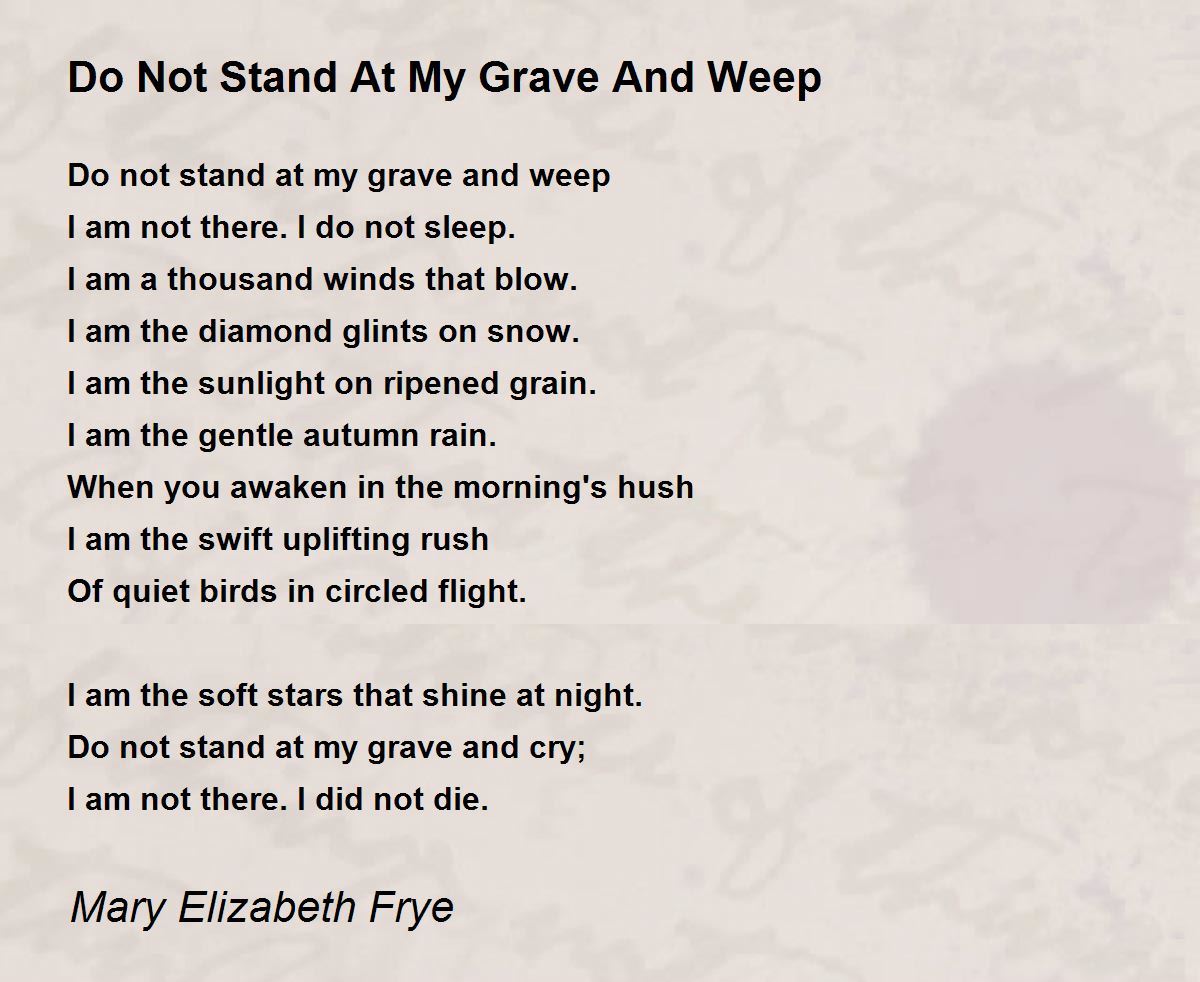

Do Not Stand at My Grave and Weep Analysis Mary Elizabeth Frye Characters archetypes. Why did he use? short summary describing. College Education is now free!ĭo Not Stand at My Grave and Weep Analysis Mary Elizabeth Frye critical analysis of poem, review school overview. Mary Elizabeth Frye was a Baltimore housewife who knew nothing about poetry and never got a formal education. Do Not Stand At My Grave And Weep is one of the most popular poems in the English language.
#Do not stand at my grave and weep free
Free Online Education from Top Universities Do Not Stand At My Grave And Weep is the only known poem written by American poet, Mary Elizabeth Frye. Due to Spam Posts are moderated before posted. No requests for explanation or general short comments allowed. When you awaken in the mornings hush I am the swift uplifting rush Of quiet birds in circled flight. This may only be an analysis of the writing. Do not stand at my grave and weep I am not there. It has been read at memorials repeatedly over the years, ie.,: various celebrities, and the five astronauts who died in the Challenger space shuttle disaster. This poem is hailed in the press as "the most requested poem in the English language in the past 60 years" and "the poem that takes the nation by storm." Since then, the true origin still remains a mystery but, there are several authors that claim authorship: Mary Frye - Gwydion Penderwen - Joyce Fossen - Albert Spengler Many assumed at first that the soldier had written it, but later this proved to be false.
#Do not stand at my grave and weep tv
The poem alludes to those mourning a loved one, and was read in 1995, on the BBC TV on Remembrance Day by Mr Cummins' father. The poem, "Do not Stand at my Grave and Weep" was left in an envelope for his parents by a soldier by the name of Stephens Cummins who at the age of 24 was killed on active service in Nothern Ireland, when a mine blew up an armoured car near Londonderry - to be opened in the event of his death. over all assment is that i would have to spend a great deal more time studying the peom to give it justice. to make it part of the world and so public is to open peoples minds to what is beond death. It’s 236×158 stitches, so a substantial size piece. It’s a great chart, you can stitch in any color thread you would like of course. If you have someone whom you would like to remember this way. the angels telling mery the jesus in no longer in the tomb and so forth. Do Not Stand At My Grave And Weep Stitched Poem. I did not die" this quote is classic from a chirstain stand point. its beauty within death attracts me as a reader. i read the comment on the oringin of this poem and do not know what to think except who ever took the time to write this and send it to the parents had to known the heart of God. yet i can not see how dropping it in this peom would impove its quality. I tend not to be found of "i am" even in high school english class the emphys is to drop the use of "i am " with in all writings. it made the consistane of the peom not over drawn. I am a thousand winds that blow, I am the diamond glints on snow, I am the sun on ripened grain, I am the gentle autumn rain. Thridly the words that where choosen were to convay a stonge image and yet keeping strickly to the point. Secondly the word choice is refreshing because of its lack of repition descriptiveness. So.First the rythem is flows smothly throughout the piece. The need for an all-powerful protector certainly becomes more pressing in many people and the consolation that such protection affords is invaluable. Does increasing age bring us closer to God or at least to some kind of godless piety? Perhaps. Sometimes I even come close to a sort of religiosity that I 'religiously' avoided in the past.

I personally have become more spiritual, more contemplative, more solemn in some ways, though I always was a deep thinker, constantly mulling things over in my head and looking for a deeper meaning in things and events. The past is the familiar, both people and things, and it takes on ever-greater importance whilst the future is downgraded or shunned altogether. One feels safer in the past than the future, and the present is seen to go by too swiftly. With the passage of the years and the approach of 'old' age, let us say, so many things take on a different hue and look and feel different in the light of one's accumulated experiences and learnt lessons. Some day it may be my own epitaph and, as such, I am indebted to the author for penning it. Now I read it and feel I could have written it myself, so much does it echo my own thoughts and feelings.

Over the years, as I read it to myself from time to time, it has taken on an ever growing significance. I came across this beautiful but poignant poem many years ago and was myself not a little moved by its stark yet selfless message.


 0 kommentar(er)
0 kommentar(er)
